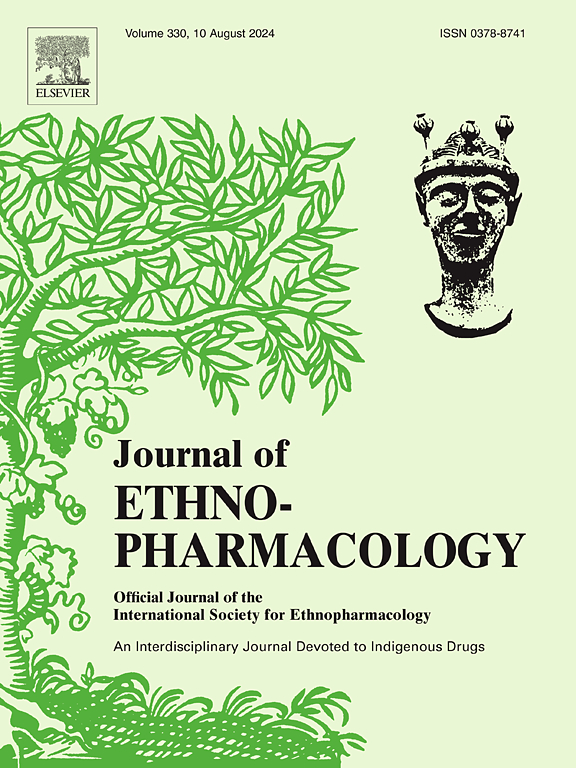Sijunzi decoction improves lipid metabolism via regulation of Wnt/β-catenin signaling pathway in diabetic mice and 3T3-L1 cells
IF 4.8
2区 医学
Q1 CHEMISTRY, MEDICINAL
引用次数: 0
Abstract
Ethnopharmacological relevance
Sijunzi decoction (SJZD), a traditional Chinese medicinal formula with the functions of invigorating the Spleen and replenishing Qi, has been clinically used for the management of diabetes, but its actions and underlying mechanisms on diabetic lipid metabolism remain largely unknown.
Aim of the study
To explore the effects of SJZD on lipid metabolism disorders and its association with the Wnt/β-catenin pathway in the white adipose tissue of diabetic mice and 3T3-L1 cells.
Materials and methods
The diabetic lipid metabolism disorders models were established by high-fat diet/streptozotocin in mice and palmitic acid in 3T3-L1 cells, respectively. The effects of SJZD on total cholesterol (TC), triglyceride (TG), low-density lipoprotein cholesterol (LDL), high-density lipoprotein cholesterol (HDL), and glucose consumption were determined by biochemical assay. Hematoxylin-eosin (H&E) staining was used to examine pathological alterations in adipose tissues. Oil red O staining was used to evaluate the differentiation of lipid droplets in 3T3-L1 adipocytes. The expression levels of Wnt10b, β-catenin, CCAAT enhancer binding protein α (C/EBP-α), sterol regulatory element-binding protein 1 (SREBP-1c), acetyl-CoA carboxylase-1 (ACC1), peroxisome proliferator-activated receptor γ (PPAR-γ), fatty acid synthase (FASN), adipose triglyceride lipase (ATGL) were examined by Western blot and/or qRT-PCR. In addition, the main components of SJZD and SJZD-containing serum (SCS) were identified by UPLC-Q-TOF-MS/MS.
Results
SJZD reduces the body fat ratio, fasting blood glucose levels, adipose tissue index and serum levels of TC, TG, and LDL, and increases the body weight, lean ratio, and serum HDL levels, as well as prevents the adipocytes hypertrophy in diabetic mice. In addition, SJZD, SCS and its ingredients (Ginsenoside Rb1 and Glycyrrhetinic acid) inhibit lipid synthesis, TG levels and promote glucose consumption in diabetic mice and 3T3-L1 adipocytes. These interventions decrease the expressions of PPAR-γ, SREBP-1c, C/EBP-α, FASN, ACC1 and P-β-catenin, and increase the expressions of ATGL, Wnt10b and β-catenin.
Conclusion
SJZD regulates the Wnt/β-catenin signaling pathway to preserve lipid metabolism homeostasis in diabetes. GRb and Gac may constitute the material basis of SJZD in attenuation of diabetic lipid metabolism disorders. These findings highlight a novel strategy for the treatment of diabetes.

求助全文
约1分钟内获得全文
求助全文
来源期刊

Journal of ethnopharmacology
医学-全科医学与补充医学
CiteScore
10.30
自引率
5.60%
发文量
967
审稿时长
77 days
期刊介绍:
The Journal of Ethnopharmacology is dedicated to the exchange of information and understandings about people''s use of plants, fungi, animals, microorganisms and minerals and their biological and pharmacological effects based on the principles established through international conventions. Early people confronted with illness and disease, discovered a wealth of useful therapeutic agents in the plant and animal kingdoms. The empirical knowledge of these medicinal substances and their toxic potential was passed on by oral tradition and sometimes recorded in herbals and other texts on materia medica. Many valuable drugs of today (e.g., atropine, ephedrine, tubocurarine, digoxin, reserpine) came into use through the study of indigenous remedies. Chemists continue to use plant-derived drugs (e.g., morphine, taxol, physostigmine, quinidine, emetine) as prototypes in their attempts to develop more effective and less toxic medicinals.
 求助内容:
求助内容: 应助结果提醒方式:
应助结果提醒方式:


